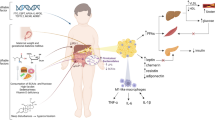Abstract
The prevalence of childhood overweight and obesity has risen during the last 30 years, not only in children with type 2 diabetes, but also those with type 1 (T1D) and this is linked with an increased cardiovascular risk. A better understanding of weight patterns in the years after diagnosis of T1D is important to identify those children with a risk for excess weight gain and strategies to decrease this. We retrospectively analyzed data of all children with T1D followed at the department of Pediatric Endocrinology Leuven and diagnosed between 1991 and 2015. Data as age, sex, BMI, and Tanner score were extracted in 390 subjects. Standardized BMI (BMI SDS) in this study group using all data was 0.26. An increase in BMI SDS was seen as a function of time since diagnosis and age, both being independent predictors. Data comparison showed a significant stronger relation between BMI SDS and both time since diagnosis and age in girls. Children diagnosed after puberty showed a higher increase in BMI SDS.
Conclusion: These longitudinal data suggest an important increase in BMI in children with T1D, both as a function of time since diagnosis and age, especially in girls.
What is Known: • The prevalence of childhood overweight and obesity is risen during the last 30 years, in children with type 2 diabetes, but also those with type 1 diabetes. | |
What is New: • Our study demonstrates with longitudinal data an increase in BMI in children with type 1 diabetes, especially girls. The increase in BMI SDS is seen as a function of time since diagnosis and age, both being independent predictors. Given the increased risk of metabolic syndrome and other complications in overweight children, special attention is needed to prevent this evolution. |





Similar content being viewed by others
Abbreviations
- BMI:
-
Body mass index
- BMI SDS:
-
Body mass index standard deviation score
- HbA1c:
-
Hemoglobin A1c
- IQR:
-
Interquartile range
- N:
-
Number
- T1D:
-
Type 1 diabetes
References
American diabetes association. Diabetes Basics. Diagnosis diabetes and learning about pre-diabetes. http://www.diabetes.org/diabetes-basics/diagnosis
Chowdhury S (2015) Puberty and type 1 diabetes. Indian J Endocrinol Metab 19:51–54
Cole TJ, Bellizzi MC, Flegal KM, Dietz WH (2000) Establishing a standard definition for child overweight and obesity worldwide: international survey. BMJ 320:1240–1243
Davis NL, Bursel JD, Evans WD, Warner JT, Gregory JW (2012) Body composition in children with type 1 diabetes in the first year after diagnosis: relationship to glycaemic control and cardiovascular risk. Arch Dis Child 97:312–315
De Vries L, Bar-niv M, Lebenthal Y et al (2014) Changes in weight and BMI following the diagnosis of type 1 diabetes in children and adolescents. Acta Diabetol 51:395–402
Direction Opérationnelle Santé Publique et Surveillance (2010) Enquête de santé par interview, Belgique 2008. Scientific Institute of Public Health, Brussels https://his.wiv-isp.be/fr/SitePages/Rapports_complets_2008.aspx. Accessed 31 May 2013
Fröhlich-Reiterer E, Rosernbauer J, Bechtold-Dalla S et al (2014) Predictors of increasing BMI during the course of diabetes in children and adolescents with type 1 diabetes: data from the German/Austrian DPV multicenter survey. Arch Dis Child 99:738–743
Gregg B, Conner C, Ruedy K et al (2015) Body mass index changes in youth in the first year after type 1 diabetes diagnosis. J Pediatr 166:1265–1269
Harell FE (2001) Regression modeling strategies. Springer, New York
Holl RW, Grabert M, Sorgo W, Heinze E, Debatin KM (1998) Contributions of age, gender and insulin administration to weight gain in subjects with IDDM. Diabetologia 41:542–547
Kaminsky LA, Dewey D (2014) The association between body mass index and physical activity, and body image, self esteem and social support in adolescents with type 1 diabetes. Can J Diabetes 38:244–249
Kaminsky BM, Klingensmith GJ, Beck RW, Tamborlane WV et al (2013) Body mass index at time of diagnosis of autoimmune type 1 diabetes in children. J Pediatr 162:736–740
Luczynski W, Szypowska A, Glowinksa-Olszewska B, Bossowski A (2011) Overweight, obesity and features of metabolic syndrome in children with diabetes and treated with insulin pump therapy. Eur J Pediatr 170:891–898
Medeiros da Costa V, de Carvalho PP, Castor Fontes de Lima G et al (2016) Overweight among children and adolescents with type 1 diabetes mellitus: prevalence and associated factors. Diabetol Metab Syndr 8:39
Newfield RS, Cohen D, Capparelli EV, Shragg P (2009) Rapid weight gain in children soon after diagnosis of type 1 diabetes: is there room for concern? Pediatr Diabetes 10:310–315
Roelants M, Hauspie R, Hoppenbrouwers K (2009) Reference for growth and pubertal development from birth to 21 years in Flanders, Belgium. Ann Hum Biol 36(6):680–694
Valerio G, Lafusco D, Zucchini S, Maffeis C (2012) Abdominal adiposity and cardiovascular risk factors in adolescents with type 1 diabetes. Diabetes Res Clin Pract 97:99–104
Verbeke G, Molenberghs G (2000) Linear mixed models for longitudinal data. Springer, New-York
Author information
Authors and Affiliations
Contributions
M De Keukelaere and K Casteels: writing of the article
S Fieuws: statistical analyses
N Reynaert, E Vandoorne, K Vande Kerckhove, and W Asscherickx: clinical data, reading, and advice
Corresponding author
Ethics declarations
Data were anonymized and the study was approved by the Ethical Review Board of the University Hospitals.
Conflict of interest
The authors declare that they have no conflicts of interest.
Informed consent
Informed consent was obtained from all individual participants included in the study.
Additional information
Communicated by Peter de Winter
Rights and permissions
About this article
Cite this article
De Keukelaere, M., Fieuws, S., Reynaert, N. et al. Evolution of body mass index in children with type 1 diabetes mellitus. Eur J Pediatr 177, 1661–1666 (2018). https://doi.org/10.1007/s00431-018-3224-9
Received:
Revised:
Accepted:
Published:
Issue Date:
DOI: https://doi.org/10.1007/s00431-018-3224-9




